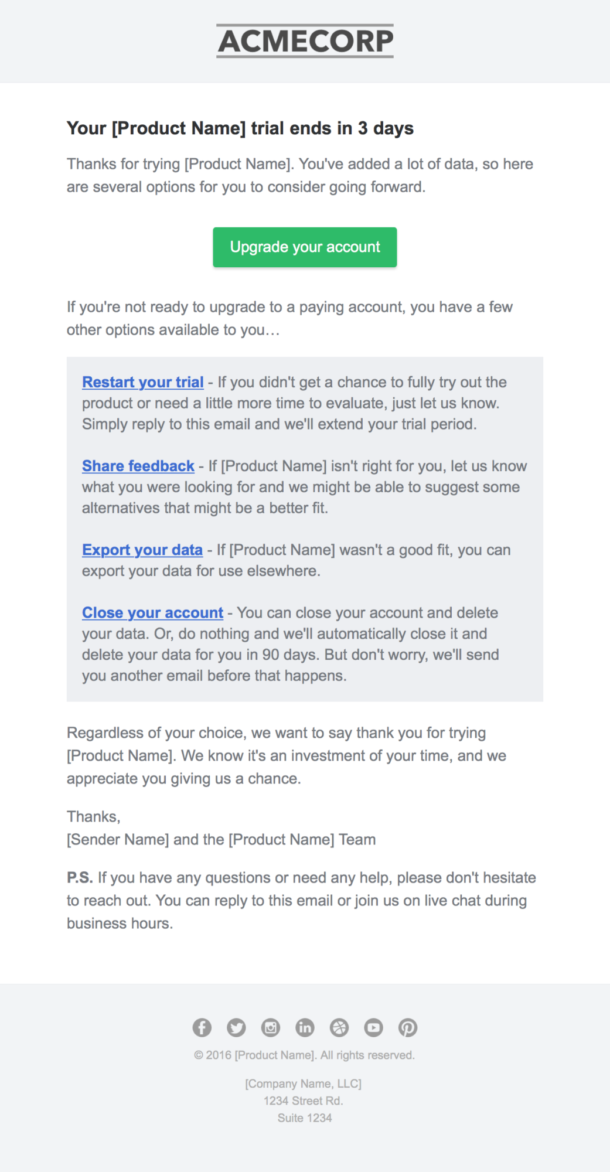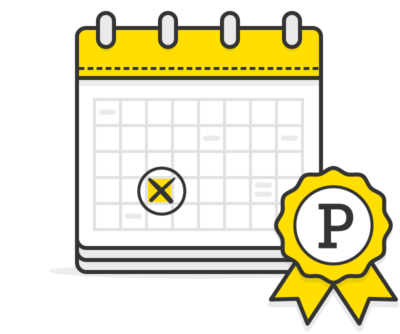Editor’s note: This guide builds on the tips from our transactional email guide that covers both content and technical best practices that apply to all of your transactional emails. It’s a great primer for transactional email in general and will help make sure you get the most value from this guide too.
Chances are pretty good that if you run a software company, your software comes with some sort of trial period. How you structure the trial period may vary, but near the end of a trial period, you should follow up with an email or two to help folks avoid any interruptions in service if they’d like to continue using it.
Trials with and without credit cards #
Your trial period can take one of two approaches. If you don’t require a credit card up front, it’s a simple trial, but if you do require a credit card up front, the end of the trial signals the beginning of charging their credit card. In either situation, you want to notify your user ahead of time, but the content of the message will vary significantly. This guide won’t address the business reasons for one approach or the other, but it will help you think through the important information to include in the email for each scenario.
Trials without a credit card #
If potential customers can try your software without providing a credit card, you’ll want to make sure they know the next steps in order to continue using the software without any interruption. In these situations, your potential customers are likely to have quite a few questions not only about the next steps but about their data, how much time they have, and how to fully activate the software.
Trials with a credit card #
Some products require a credit card up front in order to help filter potentially nefarious trial users. Some of those products automatically begin charging customers when the trial ends while others leave it up to the customers whether to continue and accept the initial charge. With the former, you’ll want to offer an opportunity to cancel and avoid the charge. With the latter, you’ll want to make it as easy as possible to continue and fully activate their account.
In most cases, the best practice when collecting a credit card up front and automatically charging it is a money-back guarantee within 30 days of the initial charge. The reality is that this approach will inevitably lead to chargebacks if you’re not incredibly generous with that refund period. Not everyone checks their statements monthly, and if they haven’t been using the product, and you’ve been charging them, they’ll usually want a refund.
Trial expiration reminders vs. trial expiration notices #
You’ll probably want to send two separate emails around trial expiration. The first is a reminder that the trial is about to end. The second would go out once the trial has ended.
What are the goals of every trial expiration email? #
1. Help them plan ahead to avoid interruptions #
Trials end. That’s just how they work, but if someone has fallen in love with your software, and their trial is coming to an end, there’s nothing more important than helping them make a painless transition to becoming a paying customer. The best way to do that is to give them as much notice as possible, make sure it’s crystal clear when the trial expires and what happens if the trial expires, and provide a link to a simple way to get going. We’ll talk about the details of all of this below.
If they’ve already provided a credit card, and they’ll be charged automatically, make sure to give them a few days notice about the charge and the credit card that they used to signup so that they aren’t surprised.
2. Make it easy for them to continue or cancel or do nothing #
Some people will signup, and some won’t. Your emails will likely be leaning towards providing help to those that want to continue using your software, but serving the people who tried it but won’t be continuing is just as important. So make sure it’s easy for people to upgrade, but make sure you’re also considering the folks that choose not to. Make it easy for them to cancel their account and delete their data. Making this process clear and easy from the email can serve as a great way to make a positive impression. Who knows? Maybe they’ll return someday.
3. Let them know how they can get help #
The transition from trial to paying customer can be a stressful one. Once your customers decide to use your software, they’ll want to make sure the transition is seamless. In some cases, they might even wonder if their existing data from the trial will be maintained. When will I be charged? I don’t have approval from accounting yet? There are countless questions and concerns people will have. This is a critical point for the customer to know that they can get help and where to find it.
What are some common mistakes with trial expiration emails? #
Trial expiration emails are special because they’re serving two very different personas. The people that want to become paying customers, and those that don’t. It’s important to address the needs of both groups without making the email confusing. Most mistakes in trial expiration emails stem from these conflicting goals.
Failing to remind people what your product is/does #
One factor that’s easy to overlook is that it’s entirely possible someone signed up for a trial but got sidetracked before they were able to check it out. In these cases, they may still be interested in taking a look, but there’s just as good of a chance they don’t even remember signing up. They may not even remember what your product does. If you have a longer trial, like 30 or 60 days, it’s even more likely that they’ve forgotten. So make sure to include a sentence or two to help them remember what your product does and why they wanted to try it in the first place.
Failing to provide enough advanced notice #
Weekends, vacations, and travel can interfere with the timing of a trial expiration. So it’s important to give someone at least three days notice about their trial expiration. Two days makes it inevitable that someone will be locked out of their account simply because they didn’t work on the weekend. Just as important, letting them know exactly when a trial will expire can help them avoid accidental interruptions.
Failing to factor in engagement and personalization #
One nice thing about software trials is that you know at least a little bit about your potential customers. Did they ever log in? Have they logged in more than once since creating the account? Did they create a significant amount of data? Did they invite other users to the account? All of these factors tell you a little about the customer’s level of engagement and enable you to customize your trial expiration emails accordingly.
If they were highly engaged during the trial and logged in recently, you can assume it’s pretty likely they’re considering becoming a customer long-term. If they never used it all, it’s less likely they’re going to signup right now, so you can tweak the email to ask if they need more time to take another look. If there’s a little data and activity, but they haven’t logged in for a couple of weeks, it could mean that they aren’t interested, or it may mean they signed up a little too early and won’t be using it until next month. In each of these situations, prioritizing the options differently, and updating the copy to anticipate their needs can really help.
Assuming that the recipient wants to begin paying for the product #
Many services make the mistake of focusing entirely on the customers that want to continue using the product, but unless you have a very special product, the number of people that won’t use your product will far outnumber those that do. Neglecting to acknowledge these folks can further distance them from ever using your product. Instead, make sure there are clear instructions for them if they’d like to completely close their account, unsubscribe from future emails, delete their data, or whatever other tasks they might want to perform before they move on.
What info should be in every trial expiration email? #
Now that we’ve covered the high-level context of those trial expiration emails, we can dive into the specific bits of data to include in your emails. Many of these are about answering key questions that recipients will have at this point and providing links to the relevant actions they might want to take.
What is this for, and what does the product do? #
It’s important to keep in mind that the recipient may not even remember signing up. If they’re evaluating multiple products, it’s possible that they barely remember yours or don’t remember it at all. The longer your trial lasts, the more likely this is. With a trial expiration, you want to make sure that some element of the email provides a clear reminder of what your product is and what it does. At the very least, you’d want to include a “What is [product name]?” link somewhere in the email.
How much time do I have left? #
The end of a trial won’t always coincide nicely with a time that’s convenient for your potential customer. By making it clear how much time is left and precisely when the trial will expire, they can more easily make a decision about their best next steps. If the trial is going to expire on a Saturday, and they know they’re on vacation the following week, they may want to go ahead and upgrade now. If they don’t have final approval, but only invited the decision maker to try it yesterday, they may need to request a little more time.
So make sure to communicate how much time is left in conjunction with the exact date and day that it will expire. Including the day of the week can really help if it’s going to expire on a weekend. That way, the recipient can stay ahead of the game and take steps to avoid an interruption in service.
What happens when the trial is over? #
What’s the story with my data? If I upgrade, will it be the same account? If I do nothing, will you automatically delete it for me? If I wait a month or two to upgrade, will my data still be there? Lots of things happen that prevent people’s lives from coinciding nicely with your product’s trial period. Things can get messy, so let them know what’s going on with their data, and everyone can breathe a little easier.
How do I upgrade? #
Ideally, a trial expiration email is designed to help prevent service interruptions for people that would like to continue using your product. So you’ll probably want the primary link to take the recipient to a page where they can add payment information or otherwise officially activate their account.
Can I have more time? #
Depending on your service, and whether you explicitly make a point to offer customers more time, this can be a very frequent request. While you may not want to offer it to everyone, explicitly offering to extend a trial for an account that has minimal or no usage is a great way to proactively help potential customers evaluate your product. Trials don’t always coincide nicely with the real world. Projects get delayed, key team members can be on vacation, and all sorts of odd timing could have prevented them from taking it for a spin.
Can I get my data out? How? #
Even when customers decide not to use your product, there’s a chance they invested a lot of effort trying it out, and they could have a meaningful amount of data that they’d like to get out. By making it clear and easy to find out how to get their data out, you’re increasing goodwill and leaving the door open that they might come back in the future.
How do I cancel? #
Since the vast majority of people will not continue using your product, many of them might want to end the relationship right now, close the account, and delete their data from your servers. Just like accessing data, make it easy and obvious for them to do this by including a link directly in the trial expiration email.
I need help! #
Despite all of your best efforts, there’s a good chance folks will have questions for you before they fully commit. You can do your best to anticipate most of the common questions, but you can’t cover everything. So make sure to include detailed information for contacting support to get those last second questions answered.
The checklist #
- Product information
- Trial expiration date (including day of week) and approximate time remaining
- Information and link for upgrading
- Information and link for extending the trial
- Information and link for closing account and/or exporting data
- Support contact information
Managing email templates is a breeze with our Templates API
Choose from our range of responsive, well-tested, email templates or code your own.
Postmark's trial expiration template #
If you follow the tips in this guide you'll send fantastic trial expiration notices. Starting to build any email can be a challenge, which is why we created templates based on all the best practices you've read in this guide.

We built the following free templates you can use, along with nicely formatted plain text versions of each template too:
- Trial expiring template, to let users know their trial is about to expire
- Trials expired template, to inform users their trial has expired
You can find these templates and learn more about the rest of our collection in our transactional email templates gallery.

If you like Postmark's templates you should check out MailMason. It's a tool we've built to streamline every aspect of creating and maintaining your transactional email messages. Every Postmark template is included out of the box with MailMason. On top of those templates MailMason gives you the power of a Grunt-based email design workflow and makes it simple to maintain all of your transactional emails. You can use Mustachio to tightly integrate with Postmark's template engine, or adapt MailMason to your workflow for another email service provider.
We want to help you send incredible transactional email messages, even if you choose to use a different email service provider. If you have any thoughts on how we can improve MailMason, we'd love for you to share them in the MailMason repository on Github.
Read all of our transactional email best practice guides #
We've assembled a series of guides on best practices for multiple types of transactional email.
- Transactional email best practices
- Welcome email best practices
- Password reset email best practices
- Receipt and invoice best practices
- User invitation best practices
- Comment notification email best practices



